Part IV Regional Profiles
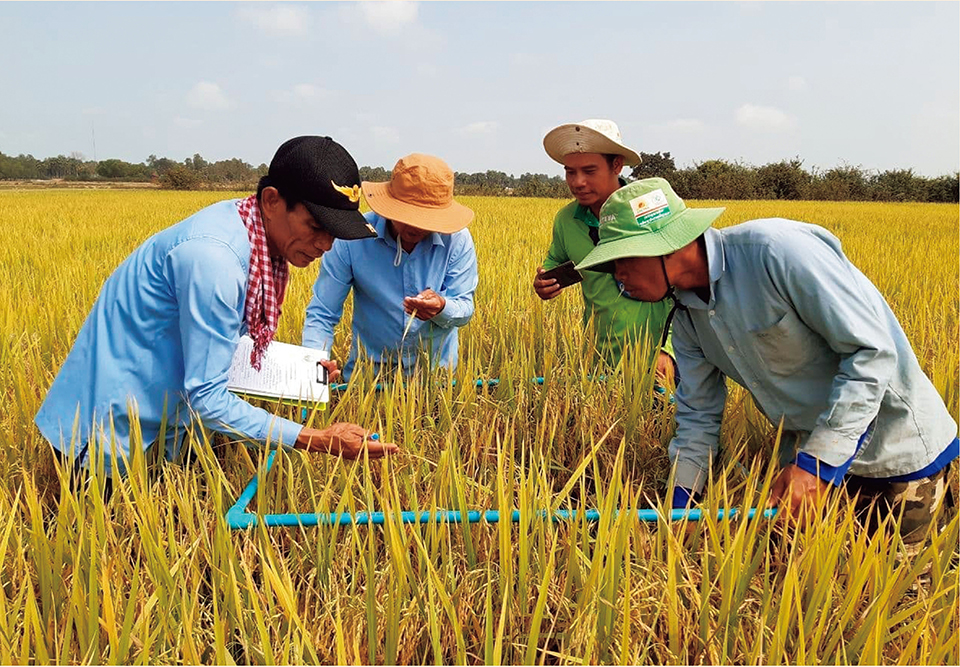
Quality inspection training for producing high-quality rice seeds as part of the technical cooperation project “Rice Seed Production and Promotion” in Cambodia (Photo: JICA)
1 East Asia
East Asia consists of a variety of countries, which include least developed countries (LDCs)Note 1 such as Cambodia and Laos; countries such as Indonesia and the Philippines, which still face large income disparities domestically despite significant economic growth; and countries such as Viet Nam, which are transitioning to a market-driven economy.
Japan has long-established political, economic, and cultural relations with these countries, which are located at the center of the Indo-Pacific region. The region’s stability and development are directly linked to the security and economic prosperity of Japan. From this perspective, Japan engages in development cooperation in light of the diverse socio-economic environments of East Asian countries and their changing development needs.
● Japan’s Efforts
Japan has contributed to the remarkable economic growth of East Asia through development cooperation that combines ODA with trade and investment, including the development of socio-economic foundations through “quality infrastructure” investment, support for institutional and human resources development, the promotion of trade, and the revitalization of private investment. In recent years, Japan aims to further enhance open regional cooperation and integration while sharing basic values, and to maintain consistent regional stability by promoting mutual understanding through youth exchanges, cultural exchanges, and projects to promote the Japanese language. In order to make Asia “a center of growth open to the world,” Japan provides support to strengthen the region’s growth potential and expand domestic demand in each country (see “Stories from the Field 5” for Japan’s efforts in human resources development in Mongolia).
■ Support for Southeast Asia
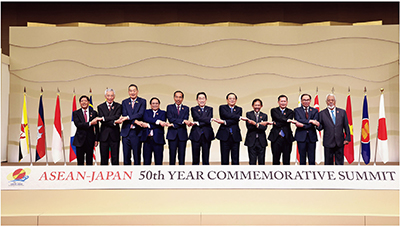
The Commemorative Summit for the 50th Year of ASEAN-Japan Friendship and Cooperation held in December 2023 (Photo: Cabinet Public Relations Office)
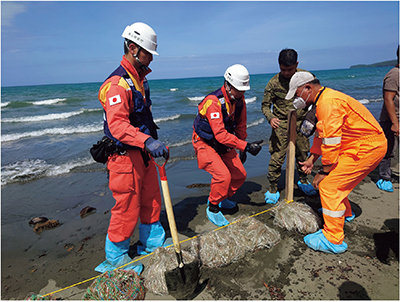
Japan Disaster Relief (JDR) Expert Team explaining the effectiveness of oil blotters and providing guidance on their installation at the beach affected by the oil spilled from a capsized tanker off the coast of Mindoro Island in the central Philippines (Photo: JICA)
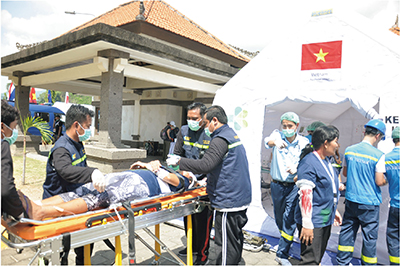
A regional collaboration drill conducted in Indonesia with Thailand as the lead country with the aim of strengthening disaster health management systems in the ASEAN region (Photo: JICA)
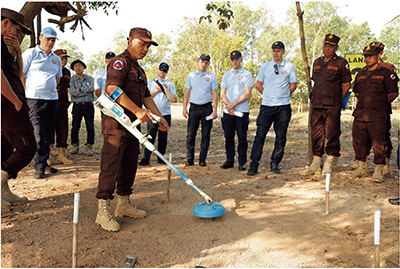
Training at the Cambodian Mine Action Centre (CMAC), a training facility, using the latest Japanese-made mine detectors for eight demining experts from the State Emergency Service of Ukraine (SESU) (Photo: JICA)
ASEAN countriesNote 2 are located along Japan’s sea lanes and have strong economic ties with Japan, with approximately 15,900 business establishments of Japanese companies operating in the region as of October 2022. The ASEAN region is of great importance to Japan, both politically and economically. ASEAN declared the establishment of the “ASEAN Community” (2015) and is making efforts to strengthen connectivity and narrow the development gaps within the region. Moreover, the “ASEAN Outlook on the Indo-Pacific (AOIP)”Glossary (2019) advocates the rule of law, openness, freedom, transparency, and inclusivity as ASEAN’s principles of action, sharing many fundamental principles with a “Free and Open Indo-Pacific (FOIP)” promoted by Japan. At the ASEAN-Japan Summit in November 2020, the “Joint Statement of the 23rd ASEAN-Japan Summit on Cooperation on ASEAN Outlook on the Indo-Pacific” was adopted. The leaders reaffirmed the shared fundamental principles of the AOIP and FOIP and agreed to further reinforce the ASEAN-Japan Strategic Partnership through enhanced practical cooperation and synergy in the four areas outlined in the AOIP (maritime cooperation, connectivity, the Sustainable Development Goals (SDGs), and economic and other possible areas of cooperation). In 2023, which marked the historic milestone of the 50th Year of ASEAN-Japan Friendship and Cooperation, a joint statement was adopted at the ASEAN-Japan Summit in September to establish the ASEAN-Japan Comprehensive Strategic Partnership (CSP). To conclude the 50th anniversary, the Commemorative Summit for the 50th Year of ASEAN-Japan Friendship and Cooperation was held in Tokyo in December, and the leaders adopted the Joint Vision Statement on ASEAN-Japan Friendship and Cooperation, which outlined a new vision for cooperation and its Implementation Plan, which outlines 130 specific cooperation items.
Japan is enhancing cooperation in light of ASEAN’s initiatives in this way and provides assistance through ODA in a wide range of areas such as infrastructure development, the rule of law, maritime safety, disaster risk reduction, health and medical care, and peacebuilding, focusing on strengthening connectivity and narrowing the development gaps as its pillars of cooperation. Additionally, in light of the increasing importance of leveraging the financial resources of the private sector and Multilateral Development Banks in the area of development, at the ASEAN-Japan Commemorative Summit in December, a policy was announced to boost the private investment for strengthening connectivity, climate change measures, and support for micro, small, and medium-sized enterprises and start-ups aiming to mobilize 35 billion US dollars in public and private funds over five years for the ASEAN region as a new effort in public-private partnership for finding solutions through co-creation.
With regard to strengthening connectivity, Japan supports the enhancement of ASEAN connectivity based on the “Master Plan on ASEAN Connectivity 2025,”Glossary which aims to strengthen “physical connectivity,” “institutional connectivity,” and “people-to-people connectivity” in the region. Japan signed the Japan-ASEAN Technical Cooperation Agreement (2019) to encourage ASEAN to consolidate its unity and centrality. In accordance with the Agreement, Japan conducted training on cybersecurity (see Part III, Section 1 (2) for details), marine plastic litter management, public international law, and treatment of criminal offenders by FY2022. Moreover, in September 2023, Japan announced the “Japan-ASEAN Comprehensive Connectivity Initiative,” which will further promote efforts to strengthen connectivity with structural and non-structural aspects. Based on this, Japan will work to strengthen multi-layered connectivity in a wide range of areas, including transport infrastructure development, digital, maritime cooperation, supply chains, electricity connectivity, and human and knowledge connectivity. It plans to conduct human resources development for 5,000 people over three years through technical cooperation.
In terms of infrastructure development, Japan works to promote “quality infrastructure” investment based on its past experiences of assisting Southeast Asian countries and in accordance with the “G20 Principles for Quality Infrastructure Investment.”Note 3 One example is the “Technical Assistance Project to Establish the Philippine Railway Institute (PRI)” assisted through ODA in Metro Manila. As urban railways are being developed in Manila, there is a need for a sustainable system for developing human resources capable of carrying out advanced operations and maintenance of the railways. To correspond to this need, the Government of the Philippines decided to establish PRI as an entity responsible for developing and supervising human resources working for railways. To establish PRI, Japan assisted in the construction of the PRI facility as part of a subway construction project with loan aid, provided simulators and other necessary training equipment with grant aid, and supported institutional building and capacity development through technical cooperation. Through this wide range of assistance, Japan contributes not only to the construction of railway infrastructure, but also to the development of railway maintenance and management capacities and related human resources.
In regard to disaster risk reduction, since 2009, Japan has continuously contributed to strengthening disaster management and disaster response capacity in ASEAN with support for the ASEAN Coordinating Centre for Humanitarian Assistance on disaster management (AHA Centre) through the Japan-ASEAN Integration Fund (JAIF),Note 4 including the establishment of a Disaster Emergency Logistic System for ASEAN (DELSA), capacity building of the ASEAN-Emergency Response and Assessment Team (ASEAN-ERAT), and the AHA Centre Executive (ACE) Leadership in Emergency and Disaster Management Programme (ACE-LEDMP). Japan implemented the “Project for Strengthening the ASEAN Regional Capacity on Disaster Health Management” (ARCH)Note 5 from 2016 to 2021 and made many achievements, including holding regional coordination drills for disaster health management teams from ASEAN countries and developing standard operation procedures related to disaster health management. Furthermore, in the subsequent Phase 2 Project for Strengthening the ASEAN Regional Capacity on Disaster Health Management (ARCH2), Japan also works to strengthen coordination capacities in this field through the co-creation of knowledge on disaster health management within the region, including by hosting the ASEAN Academic Conference on Disaster Health Management and promoting mutual learning through peer support among ASEAN countries.
Japan fully supports the establishment of the ASEAN Centre for Public Health Emergencies and Emerging Diseases, including by contributing approximately 5.5 billion yen (50 million US dollars) to JAIF in 2020. This is part of Japan’s contributions to strengthening the capacity of the ASEAN region to address public health emergencies and to prevent, detect, and respond to emerging infectious diseases. In October 2021 and February 2022, Japan held online training for public health officials from ASEAN countries responsible for the Centre’s operations. Japan also makes arrangements to dispatch experts to the Centre.
With regard to the area of human resources development, Japan works on developing approximately 80,000 people over five years from 2019, including in the digital sector such as artificial intelligence (AI), under the “Industrial Human Resource Development Cooperation Initiative 2.0” announced at the ASEAN-Japan Summit in 2018. Japan provides support to Thailand in establishing “Kosen schools (Technical Colleges),” which are unique to the Japanese education system and provide Kosen education with the same standards as those in Japan, as part of its contribution to the development of industrial human resources in the ASEAN region. In addition, Japan implements the “Innovative Asia” initiative, which supports the circulation of competent human resources in Asian countries including ASEAN through studying abroad at Japanese graduate schools or other institutions, internships at Japanese companies, etc., with the aim of promoting innovation in Asia including Japan. Over the five years from FY2017 to FY2021, Japan had accepted people from all across Asia under this project.
Japan also engages in economic cooperation, holding investment seminars, invitation programs, and the “BIMP-EAGA+Japan” dialogue for the East ASEAN Growth Area (BIMP-EAGA).Note 6 In 2021, the construction of fishing port facilities and a fish market was completed on Biak Island in Papua Province, Indonesia, and since 2022 tuna unloaded at the port has been exported to Japan. In addition, the construction of fishing ports and markets began in 2023 in the other remote islands of Sabang (Aceh Province), Morotai (North Maluku Province), Moa (Maluku Province), and Saumlaki (Maluku Province).
With regard to the Mekong region,Note 7 which has great potential for development among the ASEAN countries, the Mekong-Japan Summit Meeting has been held since 2009. Around once every three years, it is held in Japan, where Japan and the Mekong countries adopt an assistance policy for the region.
Japan has been focusing on strengthening connectivity critical for economic growth in the region and making progress on the projects under the “Tokyo Strategy 2018,”Note 8 such as the development of the Sihanoukville Port in Cambodia and the Vientiane International Airport in Laos, the construction of the Ho Chi Minh City urban railway in Viet Nam, and the construction of the Mass Transit System (Red Line) in Bangkok, Thailand.
Based on the “Mekong-Japan Initiative for SDGs toward 2030” announced in 2019, Japan makes use of “quality infrastructure” investment in line with international standards so as to draw out the Mekong region’s potential in an optimal manner, while focusing its efforts on the three priority areas of (i) environmental and urban issues, (ii) sustainable natural resource management and utilization, and (iii) inclusive growth. As a concrete effort for this, Japan provides support for community-based socio-economic development and the realization of the SDGs in the Mekong countries through the “KUSANONE Mekong SDGs Initiative.” Japan will continue to promote the SDGs in the Mekong region based on the “Mekong-Japan Initiative for SDGs toward 2030” in order to make the region more sustainable, diverse, and inclusive.
Furthermore, to support the implementation of development projects by private companies and others and contribute to the development of the Mekong region, Japan promotes the “Five Points of Cooperation:” (i) promotion of loans and investments for the private sector, (ii) grant assistance for Grass-Roots Human Security Projects that are designed to assist small communities, (iii) cooperation on the rule of law, (iv) maritime cooperation, and (v) cooperation on the development of supply chains, including through the “Mekong SDGs Investment Partnership.”
Japan provided Laos, which holds the ASEAN Chairmanship in 2024, with IT equipment and vehicles for the preparation of relevant meetings and conferences. Additionally, Japan signed an agreement on the provision of equipment necessary for clearing unexploded ordnance and launched in January 2023 the “Project for Integrated Energy Master Plan towards Sustainable Carbon Neutral Society,” which aims to formulate a master plan on the long-term energy transition for achieving a carbon-neutral society.
■ Assistance for Myanmar
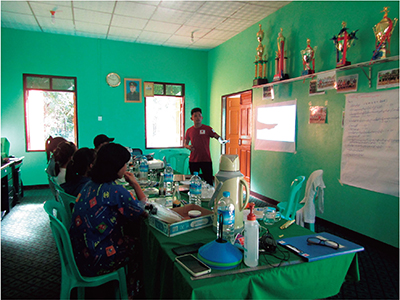
In Hpa-an Township, Kayin State, Myanmar, a Japanese NGO helping local residents learn the types and characteristics of disabilities at the workshop for community volunteers (Photo: Association for Aid and Relief, Japan (AAR Japan))
In Myanmar, since the coup d’état in February 2021, the Government of Japan has consistently urged the Myanmar military to take concrete actions to (i) immediately stop the violence, (ii) release those who are detained, including State Counsellor Aung San Suu Kyi, and (iii) swiftly restore Myanmar’s democratic political system. In view of the current situation in the country, Japan decided not to initiate a new ODA project with the military regime.
Meanwhile, the humanitarian situation in Myanmar continues to deteriorate, and delivering humanitarian assistance is an urgent issue. Therefore, Japan proactively provides humanitarian assistance via international organizations, NGOs, and other organizations, directly benefiting the people of Myanmar, and has provided a total of more than 109.5 million US dollars in humanitarian assistance to date. In February 2023, through numerous international organizations and the ASEAN Secretariat, Japan decided to provide assistance to those who are affected by the coup with food, medical items, shelters, water and sanitation infrastructure, nutritional improvement, medical services, access to education, and measures to combat illegal drugs, and the implementation is ongoing. In addition, in response to the damage caused by the powerful cyclone “Mocha” that struck Myanmar and Bangladesh in May, Japan supported humanitarian operations in the fields of food, water and sanitation, and other areas through international organizations by providing Emergency Grant Aid.
One example where the Government of Japan provides humanitarian assistance through a Japanese NGO is the Japan Platform (JPF)Note 9 that operates in the fields of food and supplies, water and sanitation, health and medical care, protection, and education within Myanmar and Thailand. In addition, through the Grant Assistance for Japanese NGO Projects, project implementation is underway in fields such as health and medical care, education, and energy, which are conducive to medium- to long-term socio-economic development in Myanmar and Thailand. Based on the local situation, and humanitarian needs and emergencies, the Government of Japan will continue to work with international organizations and NGOs and to actively deliver humanitarian assistance to the people in need in Myanmar, in order to reach out to those who are facing difficulties.
Glossary
- ASEAN Outlook on the Indo-Pacific (AOIP)
- An initiative to create a vision of even closer cooperation in the Indo-Pacific and strengthen ASEAN-centered regional architecture. It is not aimed at creating new mechanisms or replacing existing ones; rather, it is intended to enhance ASEAN’s community building process and to better face challenges arising from the current and future regional and global environments. The initiative shares many fundamental principles with a “Free and Open Indo-Pacific (FOIP)” promoted by Japan.
- Master Plan on ASEAN Connectivity 2025 (MPAC 2025)
- An action plan for strengthening ASEAN connectivity that was adopted at the ASEAN Summit in 2016 as the successor to the “Master Plan on ASEAN Connectivity” (adopted in 2010). It is positioned as a part of “ASEAN 2025: Forging Ahead Together” (adopted in 2015). The document stipulates “sustainable infrastructure,” “digital innovation,” “seamless logistics,” “regulatory excellence,” and “people mobility,” as its major strategies, and presents priority initiatives under each strategy.
- Note 1: See the glossary.
- Note 2: The 10 ASEAN member states are Brunei, Cambodia, Indonesia, Laos, Malaysia, Myanmar, the Philippines, Singapore, Thailand, and Viet Nam.
- Note 3: See the glossary “Quality Infrastructure”.
- Note 4: A fund established in 2006 to support ASEAN’s endeavors to advance integration by correcting regional disparities, aiming at the establishment of an ASEAN Community. Japan announced its contribution of a total of 7.5 billion yen (approximately 70.1 million US dollars) at the 2005 ASEAN-Japan Summit, and later contributed a total of 100 million US dollars to the “JAIF 2.0” in 2013. Japan provided additional contributions in 2019, 2020, 2021, and 2022.
- Note 5: A project to create a framework to implement the policy of the ASEAN Declaration on “One ASEAN, One Response: ASEAN Responding to Disasters as One” (2014 ASEAN Ministerial Meeting on Disaster Management). In 2017, the “ASEAN Leader’s Declaration (ALD) on Disaster Health Management” (2017) clearly incorporated the need for the activities engaged in through ARCH.
- Note 6: A regional framework established in 1994 by Brunei, Indonesia, Malaysia, and the Philippines to promote economic growth in the developing regions of these four countries.
- Note 7: A region including the five countries of Cambodia, Laos, Myanmar, Thailand, and Viet Nam.
- Note 8: Adopted at the 10th Mekong-Japan Summit Meeting in Tokyo in 2018. It outlines the direction of Japan’s cooperation with Mekong.
- Note 9: See the glossary.
